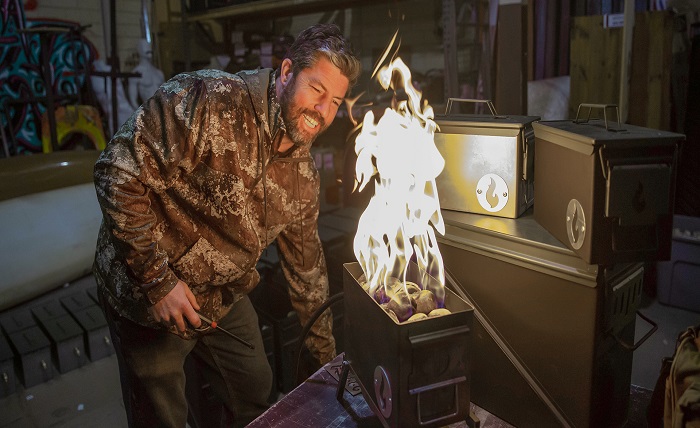What is a Colorado Campfire and How to Make One

If you love camping and outdoor cooking, you might have heard of the term “Colorado campfire”. But what exactly does it mean and how do you make one? In this blog post, we will answer these questions and give you some tips on how to enjoy a Colorado campfire safely and responsibly.
What is a Colorado Campfire?
A Colorado campfire refers to a particular style of building and maintaining an outdoor fire that originated in the Rocky Mountains. This method of making a campfire isn’t merely about creating warmth or cooking food. It’s about engaging with nature, respecting the environment, and leaving no trace behind.
A Colorado campfire is made by digging a shallow pit in the ground, lining it with rocks, and filling it with dry wood and tinder. The fire is then lit and kept small and contained within the pit. The rocks help to reflect the heat and prevent the fire from spreading. The pit also makes it easier to cover the fire with dirt when it’s time to put it out.
A Colorado campfire is ideal for cooking food over the coals or using a grill or a tripod. Some of the traditional dishes that are cooked over a Colorado campfire include cornbread, beans, chili, stew, and s’mores. However, you can also get creative and try your own recipes or use different types of fuel, such as charcoal or wood pellets.
How to Make a Colorado Campfire
Making a Colorado campfire is not difficult, but it does require some preparation and caution. Here are some steps that you should follow to make a successful Colorado campfire:
- Choose a suitable location. You should always make your campfire in a designated fire ring or pit, if available. If not, you should choose a spot that is at least 15 feet away from any flammable materials, such as trees, grass, tents, or other camping gear. You should also avoid making your fire on top of organic soil or vegetation, as they can smolder and cause underground fires.
- Dig a shallow pit. You should use a shovel or a trowel to dig a pit that is about 6 inches deep and 18 inches wide. You should also clear away any debris or rocks from around the pit.
- Line the pit with rocks. You should find some medium-sized rocks that are dry and not cracked. You should arrange them around the edge of the pit to form a circle. This will help to contain the fire and reflect the heat.
- Gather your fuel. You should only use dry wood that is dead and fallen from trees. You should never cut down live trees or branches for your fire. You should also avoid using wood that has been treated with chemicals or paint, as they can release toxic fumes when burned. You should collect three types of wood: tinder, kindling, and fuelwood. Tinder is small and thin material that can catch fire easily, such as dry leaves, grass, pine needles, or paper. Kindling is slightly larger material that can burn quickly, such as twigs, small sticks, or bark. Fuelwood is larger material that can burn for a long time, such as logs or branches.
- Build your fire. You should start by placing some tinder in the center of the pit. Then you should add some kindling on top of the tinder in a teepee or cross shape. Finally, you should add some fuelwood on top of the kindling in a log cabin or lean-to shape. You should leave some space between the pieces of wood to allow air to circulate.
- Light your fire. You should use a match or a lighter to ignite the tinder at the base of the fire. You should blow gently on the flames to help them spread to the kindling and fuelwood. You should never use gasoline or other flammable liquids to start your fire, as they can cause explosions or injuries.
- Maintain your fire. You should keep your fire small and under control at all times. You should never leave your fire unattended or let it get too large or too hot. You should add more fuelwood as needed, but not too much at once. You should also keep a bucket of water or a shovel nearby in case of emergencies.
- Put out your fire. When you are done with your fire, you should extinguish it completely before leaving or going to sleep. You should use water or dirt to douse the flames and coals until they are no longer glowing or smoking. You should stir the ashes with a stick or shovel to make sure they are wet and cool. You should also replace any rocks that you moved from around the pit.
Why Make a Colorado Campfire?
There are many benefits of making a Colorado campfire over other types of campfires. Some of them are:
- It is safer. A Colorado campfire is less likely to cause wildfires or injuries, as it is contained within a pit and surrounded by rocks. It also produces less smoke and sparks, which can irritate your eyes or lungs or start accidental fires.
- It is cleaner. A Colorado campfire leaves less impact on the environment, as it uses less wood and burns more efficiently. It also reduces the amount of ash and debris that you have to dispose of or pack out.
- It is more enjoyable. A Colorado campfire creates a cozy and intimate atmosphere, as it radiates heat and light in all directions. It also allows you to cook delicious food over the coals or use a grill or a tripod. It also invites you to sit around and share stories, songs, or games with your friends or family.
Conclusion
A Colorado campfire is a great way to enjoy the outdoors and have fun with your camping companions. It is also a responsible and respectful way to interact with nature and leave no trace behind. By following the steps and tips in this blog post, you can make your own Colorado campfire and experience its benefits for yourself. Happy camping!





